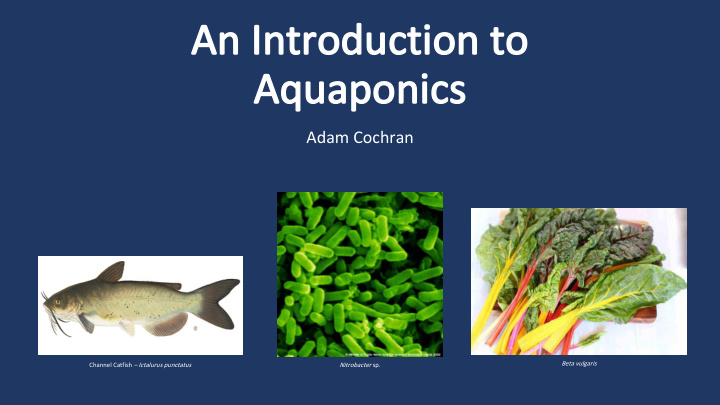



An Introduction to Aquaponics Adam Cochran Beta vulgaris Channel Catfish – Ictalurus punctatus Nitrobacter sp.
A little about me…. • Lead Faculty for the Sciences - Columbia Southern University • Adjunct Biology Instructor - Mountain View College • M.A. in Ecology – University of North Texas • North Texas Master Naturalist • Gardening since the late 90s – Container, Soil, Hydroponics, Aquaponics
Growing Food Crops • Soil - ”in ground” farming, using the native soil • Containers/Raised beds – Pots or raised structures using non-native soil medium • Hydroponics – Water culture: growing plants in oxygenated water + nutrients, largely sterile • Aquaponics – Water culture: raising fish* and plants together, nitrogenous fish waste fertilizes, dependent on microbes * May include other organisms
Soil (Outdoors) Pros • Relatively inexpensive • Excellent yields • Soil is somewhat “forgiving” • Good water retention • “Terroir” – if you’re inclined to believe • Fertilizer options are many Cons • Considerable space needed; plants need space • Greater need for pesticides/herbicides • At the mercy of the elements, every year is a surprise • Irrigation/water needs heavy
Containers - Raised Beds Pros • Easier to maintain that in ground gardening • Tend to be neater and more organized • Weeds often less of an issue Cons • Tend to dry out • Can be difficult to maintain microbial activity (organic gardening) • Build up of fertilizers salts or other dissolved solids • Can be overtaken by underground roots (raised beds)
Hydroponics Pros • Concentrated production • Far less space needed than soil • Outdoor and Indoor • Variety of techniques • Excellent yield • ~70% less water needed than soil Cons • Expensive – fertilizers, grow medium, pH buffers • Maintaining pH can be a problem • More difficult to maintain outdoors • Nutrient concentrations must be maintained • Not practical for some crops
Aquaponics Pros • Concentrated production • Less space needed than soil • Outdoor and Indoor • Variety of techniques • Excellent yield • ~70% less water needed than soil • pH problems fewer than hydroponics once system established Cons • Somewhat expensive to start • More difficult to maintain outdoors • Nutrient concentrations must be maintained • Not practical for some crops • System size a factor, depending on climate This Photo by Unknown Author is licensed under CC BY-SA
Techniques A Little Background This Photo by Unknown Author is licensed under CC BY-NC-ND
Hydroponic Techniques Nutrient Film Technique or “NFT”
Nutrient Film Technique or “NFT” This Photo by Unknown Author is licensed under CC BY-SA
Nutrient Film Technique or “NFT”
Hydroponic Techniques Deep Water Culture or “DWC”
Deep Water Culture or “DWC” This Photo by Unknown Author is licensed under CC BY-SA-NC
Hydroponic Techniques Constant Flow / Ebb and Flow
Constant Flow / Ebb and Flow
Constant Flow / Ebb and Flow Grow Media Options • Gravel – cheap, very heavy, can cause pH problems • Expanded Clay - “Hydroton” – expensive, light, excellent grow medium! • Expanded Shale – heavy, relatively cheap and easy to find • Pumice – volcanic rock, can be used for filler, heavy, cheap • Grow stone – “puffed” glass – light, excellent grow medium , expensive
Wicking Bed
Aquaponics – How Does It Work? Nitrifying Bacteria • Nitrobacter sp. • Nitrococcus sp. Ammonia -> Nitrites -> Nitrates (Fertilizer)
Establishing a “Cycle” – Making Microbes Happy and Abundant • Dechlorination/Dechloramination – Time, Vitamin C Tablets With Fish or Fishless • With Fish – a few fish are introduced to system, may die, dead fish provide ammonia as they decompose • Fishless – Pure ammonia is added to system before fish are put in • Ammonia levels are checked using a testing kit • As ammonia levels drop, nitrites are tested • Once nitrite levels quickly drop to ‘0’, system is ready for fish • May take weeks to establish • ’Slime’ on surfaces coincides with established cycle
It’s Grow Time – What to Raise/Grow? Animals • Fish (tilapia, catfish, trout, goldfish, sunfish, bass, carp) • Crayfish • Freshwater mussels • Snails • Worms (vermiponics) • Do we need animals at all? Vegetables • Will depend on type of system • Leafy vegetables tend to be the best choice for aquaponics
Crops Successful in MVC Systems • Basil • Chard • Lettuce (all varieties) • Parsely • Cucumbers (need pollination) • Melons (need pollination) • Okra (HUGE) • Edible Gourds • Squash • Tomatoes (to an extent)
Fish in MVC Systems • Goldfish • Catfish • Plecostomus (algae eaters) • Tilapia
Challenges • Fire Ants • Rodents • Aphids • Hairy Crab Weed - Fatoua villosa, Basil ? • Nostoc – colonial photosynthetic bacteria • Pumps breaking • Fish disease • Mysterious Disappearing Water • Large Fish Damaging Pipes
Thank You Are There Any Questions?
Recommend
More recommend